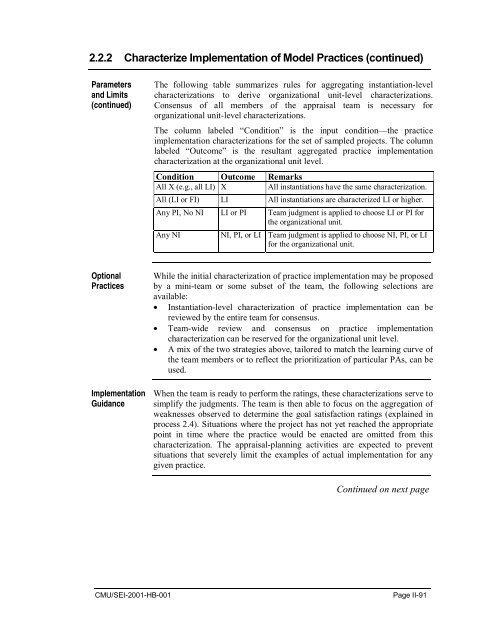Standard CMMI Appraisal Method for Process Improvement (SCAMPI)
Standard CMMI Appraisal Method for Process Improvement (SCAMPI)
Standard CMMI Appraisal Method for Process Improvement (SCAMPI)
Create successful ePaper yourself
Turn your PDF publications into a flip-book with our unique Google optimized e-Paper software.
2.2.2 Characterize Implementation of Model Practices (continued)<br />
Parameters<br />
and Limits<br />
(continued)<br />
The following table summarizes rules <strong>for</strong> aggregating instantiation-level<br />
characterizations to derive organizational unit-level characterizations.<br />
Consensus of all members of the appraisal team is necessary <strong>for</strong><br />
organizational unit-level characterizations.<br />
The column labeled “Condition” is the input condition—the practice<br />
implementation characterizations <strong>for</strong> the set of sampled projects. The column<br />
labeled “Outcome” is the resultant aggregated practice implementation<br />
characterization at the organizational unit level.<br />
Condition Outcome Remarks<br />
All X (e.g., all LI) X<br />
All instantiations have the same characterization.<br />
All (LI or FI) LI All instantiations are characterized LI or higher.<br />
Any PI, No NI LI or PI Team judgment is applied to choose LI or PI <strong>for</strong><br />
the organizational unit.<br />
Any NI NI, PI, or LI Team judgment is applied to choose NI, PI, or LI<br />
<strong>for</strong> the organizational unit.<br />
Optional<br />
Practices<br />
Implementation<br />
Guidance<br />
While the initial characterization of practice implementation may be proposed<br />
by a mini-team or some subset of the team, the following selections are<br />
available:<br />
• Instantiation-level characterization of practice implementation can be<br />
reviewed by the entire team <strong>for</strong> consensus.<br />
• Team-wide review and consensus on practice implementation<br />
characterization can be reserved <strong>for</strong> the organizational unit level.<br />
• A mix of the two strategies above, tailored to match the learning curve of<br />
the team members or to reflect the prioritization of particular PAs, can be<br />
used.<br />
When the team is ready to per<strong>for</strong>m the ratings, these characterizations serve to<br />
simplify the judgments. The team is then able to focus on the aggregation of<br />
weaknesses observed to determine the goal satisfaction ratings (explained in<br />
process 2.4). Situations where the project has not yet reached the appropriate<br />
point in time where the practice would be enacted are omitted from this<br />
characterization. The appraisal-planning activities are expected to prevent<br />
situations that severely limit the examples of actual implementation <strong>for</strong> any<br />
given practice.<br />
Continued on next page<br />
CMU/SEI-2001-HB-001<br />
Page II-91
















